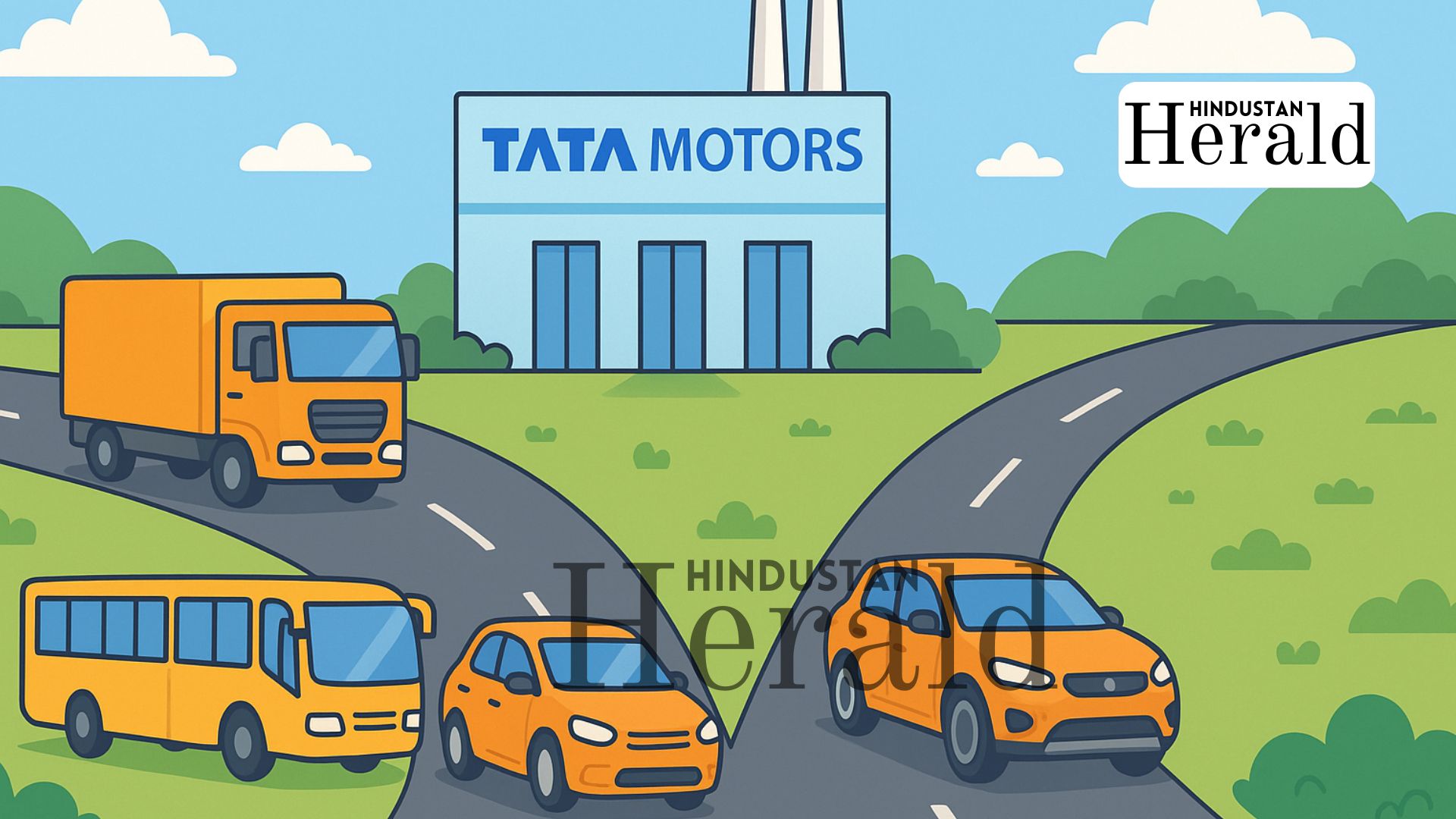New Delhi, October 1: Tata Motors began a new chapter today. The company that built India’s first indigenously developed car has formally split itself into two. One arm will now carry the commercial vehicle (CV) business, the backbone of India’s highways and freight movement. The other will hold the passenger vehicle (PV) and Jaguar Land Rover (JLR) businesses, including its fast-growing electric fleet.
This restructuring has been in the works for years, but its timing is deliberate. The auto sector is shifting fast domestic freight cycles are volatile, EV adoption is accelerating, and global luxury markets remain uncertain. By drawing a line between trucks and passenger cars, Tata Motors is betting that sharper focus will fetch better growth and better valuations.
A Split, But Not A Break-Up
The demerger, which came into effect on 1 October 2025, is structured as a 1:1 share swap. For every fully paid share of Tata Motors, investors will receive one share of the new CV entity, TMLCV. The company has set 14 October 2025 as the record date to decide who gets what. Both entities are slated to be listed on the BSE and NSE, subject to approvals.
This isn’t about selling off or discarding a business. Both arms remain firmly under the Tata umbrella. But the move effectively frees the CV business from being overshadowed by the swings of JLR or the buzz around Tata’s electric cars. Investors, for the first time, will be able to value the bread-and-butter truck operations separately from the glamour and risk of luxury sedans and SUVs.
A Stock That Knows How To Read The Room
The market wasted no time in reacting. Shares of Tata Motors jumped nearly 5% in intraday trade, touching ₹713.05, after opening close to ₹695. For a stock that has been choppy through the year weighed down by JLR’s export hiccups and uncertainty in global demand today’s rally felt like a release of pent-up optimism.
As one Mumbai-based fund manager put it, “This was overdue. Investors can finally make a clean call on trucks versus cars.” Technical charts showed the stock punching past its 20-day averages, adding to the cheer among traders who had been sitting on the sidelines.
Still, one day’s euphoria is not the same as sustained value creation. The CV entity’s listing will be the real moment of reckoning. And the PV–JLR unit must prove it can sustain margins in a luxury market that’s showing cracks in China and the US.
A New Captain At The Wheel
The demerger coincides with a leadership shuffle. Shailesh Chandra officially took charge as Managing Director & CEO of Tata Motors today, with a three-year mandate. Chandra isn’t new to the group. Over two decades, he’s worked across strategy, corporate planning, and most visibly, Tata’s EV division, where he helped the company emerge as India’s top electric car maker.
His appointment signals continuity but also a push towards electrification. Chandra inherits a company that has momentum in EVs, cautious optimism at JLR, and now, a leaner structure. How he balances the very different growth arcs of Tata’s businesses, mass-market cars at home, luxury models abroad, and a separated trucks arm will define his tenure.
Investors Like The Story, But Know The Risks
Brokerages are mostly upbeat. They argue that splitting CVs from PV–JLR will allow each to attract investors aligned with their risk appetites. CVs are cyclical but essential, tracking infrastructure spending and freight demand. PVs and JLR are aspirational, tech-heavy, and exposed to global markets.
But no one is pretending the path will be smooth. JLR still faces headwinds from tariffs and slowing luxury demand. The CV business, meanwhile, lives and dies by India’s infrastructure cycle and fuel costs. And on EVs, Tata may be ahead domestically, but competition from global automakers entering India is intensifying.
Earlier this year, JLR had to pause exports to the US due to regulatory issues. That single event shaved off nearly 10% of Tata Motors’ value in a day, reminding investors just how fragile global operations can be. The lesson lingers: structural changes may help, but execution risk is alive and well.
Why This Moment Feels Bigger Than A Corporate Filing
Demerger announcements often slip into the dry language of ratios and record dates. But this one carries more weight. Tata Motors is not just any company. It is one of the few firms that sits at the intersection of India’s domestic industrial economy and its global brand ambitions.
By splitting into two, Tata is effectively saying: trucks and buses will rise and fall with India’s growth story, while passenger cars and JLR will chase a different destiny, one tied to design, technology, and global consumer moods. That separation matters for investors, for competitors, and for policymakers watching how India’s auto sector positions itself in the next decade.
What Comes Next
The immediate milestone is clear: the listing of the CV unit. How the market values it will set the tone for the entire restructuring. For Tata Motors’ PV–JLR arm, the challenge is sustaining the EV lead in India while navigating the turbulence of global luxury demand. And for Shailesh Chandra, the first-time MD & CEO, the challenge is perhaps the toughest: proving that this new Tata Motors, slimmer but more focused, can deliver consistently across cycles.
For now, investors are buying the story. But the long road ahead, full of global trade risks, EV competition, and freight cycles will decide whether today’s rally was the beginning of a new journey or just a pit stop.
Stay ahead with Hindustan Herald — bringing you trusted news, sharp analysis, and stories that matter across Politics, Business, Technology, Sports, Entertainment, Lifestyle, and more.
Connect with us on Facebook, Instagram, X (Twitter), LinkedIn, YouTube, and join our Telegram community @hindustanherald for real-time updates.
Former financial consultant turned journalist, reporting on markets, industry trends, and economic policy.






